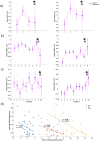When the Heart Meets the Mind: Exploring the Brain-Heart Interaction during Time Perception
- PMID: 39048314
- PMCID: PMC11340283
- DOI: 10.1523/JNEUROSCI.2039-23.2024
When the Heart Meets the Mind: Exploring the Brain-Heart Interaction during Time Perception
Abstract
Recent studies suggest that time estimation relies on bodily rhythms and interoceptive signals. We provide the first direct electrophysiological evidence suggesting an association between the brain's processing of heartbeat and duration judgment. We examined heartbeat-evoked potential (HEP) and contingent negative variation (CNV) during an auditory duration-reproduction task and a control reaction-time task spanning 4, 8, and 12 s intervals, in both male and female participants. Interoceptive awareness was assessed with the Self-Awareness Questionnaire (SAQ) and interoceptive accuracy through the heartbeat-counting task (HCT). Results revealed that SAQ scores, but not the HCT, correlated with mean reproduced durations with higher SAQ scores associating with longer and more accurate duration reproductions. Notably, the HEP amplitude changes during the encoding phase of the timing task, particularly within 130-270 ms (HEP1) and 470-520 ms (HEP2) after the R-peak, demonstrated interval-specific modulations that did not emerge in the control task. A significant ramp-like increase in HEP2 amplitudes occurred during the duration-encoding phase of the timing but not during the control task. This increase within the reproduction phase of the timing task correlated significantly with the reproduced durations for the 8 s and the 4 s intervals. The larger the increase in HEP2, the greater the under-reproduction of the estimated duration. CNV components during the encoding phase of the timing task were more negative than those in the reaction-time task, suggesting greater executive resources orientation toward time. We conclude that interoceptive awareness (SAQ) and cortical responses to heartbeats (HEP) predict duration reproductions, emphasizing the embodied nature of time.
Keywords: contingent negative variation (CNV); duration reproduction; heartbeat-counting task; heartbeat-evoked potential (HEP); time perception.
Copyright © 2024 the authors.
Conflict of interest statement
The authors declare no competing financial interests.
Figures









Similar articles
-
Heartbeat evoked potentials reflect interoceptive awareness during an emotional situation.Sci Rep. 2025 Mar 8;15(1):8072. doi: 10.1038/s41598-025-92854-4. Sci Rep. 2025. PMID: 40057611 Free PMC article.
-
Brain-heart interactions are modulated across the respiratory cycle via interoceptive attention.Neuroimage. 2022 Nov 15;262:119548. doi: 10.1016/j.neuroimage.2022.119548. Epub 2022 Aug 11. Neuroimage. 2022. PMID: 35964864
-
Brain responses and self-reported indices of interoception: Heartbeat evoked potentials are inversely associated with worrying about body sensations.Physiol Behav. 2017 Oct 15;180:1-7. doi: 10.1016/j.physbeh.2017.07.032. Epub 2017 Aug 1. Physiol Behav. 2017. PMID: 28778551
-
Interoception is associated with heartbeat-evoked brain potentials (HEPs) in adolescents.Biol Psychol. 2018 Sep;137:24-33. doi: 10.1016/j.biopsycho.2018.06.007. Epub 2018 Jun 23. Biol Psychol. 2018. PMID: 29944962
-
Heart-brain interactions shape somatosensory perception and evoked potentials.Proc Natl Acad Sci U S A. 2020 May 12;117(19):10575-10584. doi: 10.1073/pnas.1915629117. Epub 2020 Apr 27. Proc Natl Acad Sci U S A. 2020. PMID: 32341167 Free PMC article.
Cited by
-
Interoceptive signals and emotional states shape temporal perception through heart rate modulation.Front Psychol. 2025 Jul 3;16:1610347. doi: 10.3389/fpsyg.2025.1610347. eCollection 2025. Front Psychol. 2025. PMID: 40678439 Free PMC article.
References
-
- Benjamini Y, Hochberg Y (1995) Controlling the false discovery rate: a practical and powerful approach to multiple testing. J R Stat Soc Series B Stat Methodol 57:289–300. 10.1111/j.2517-6161.1995.tb02031.x - DOI
MeSH terms
LinkOut - more resources
Full Text Sources
